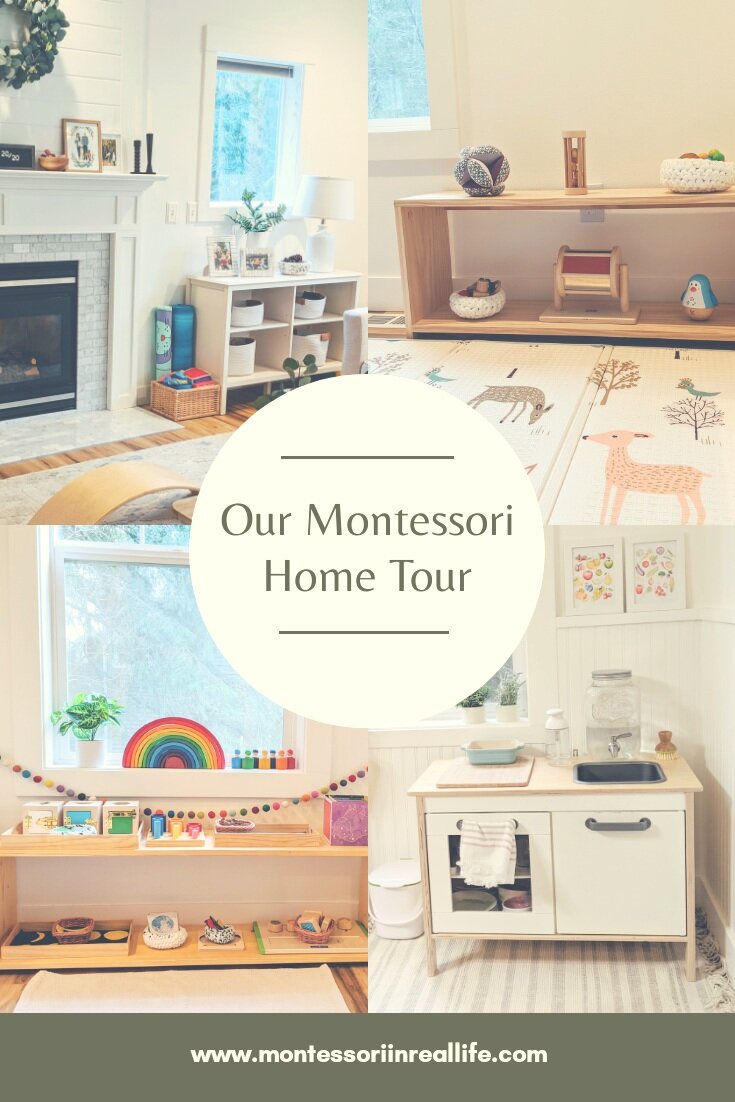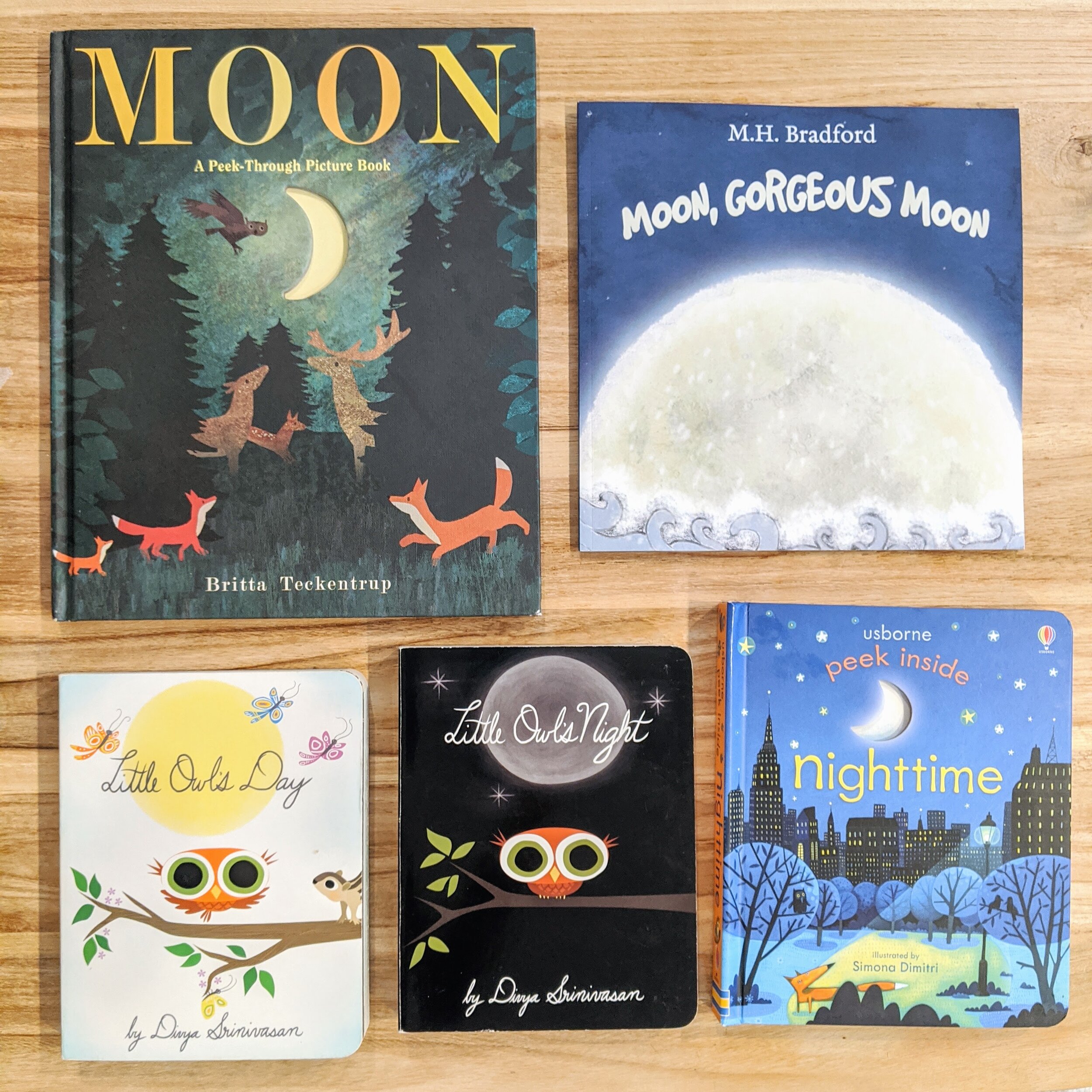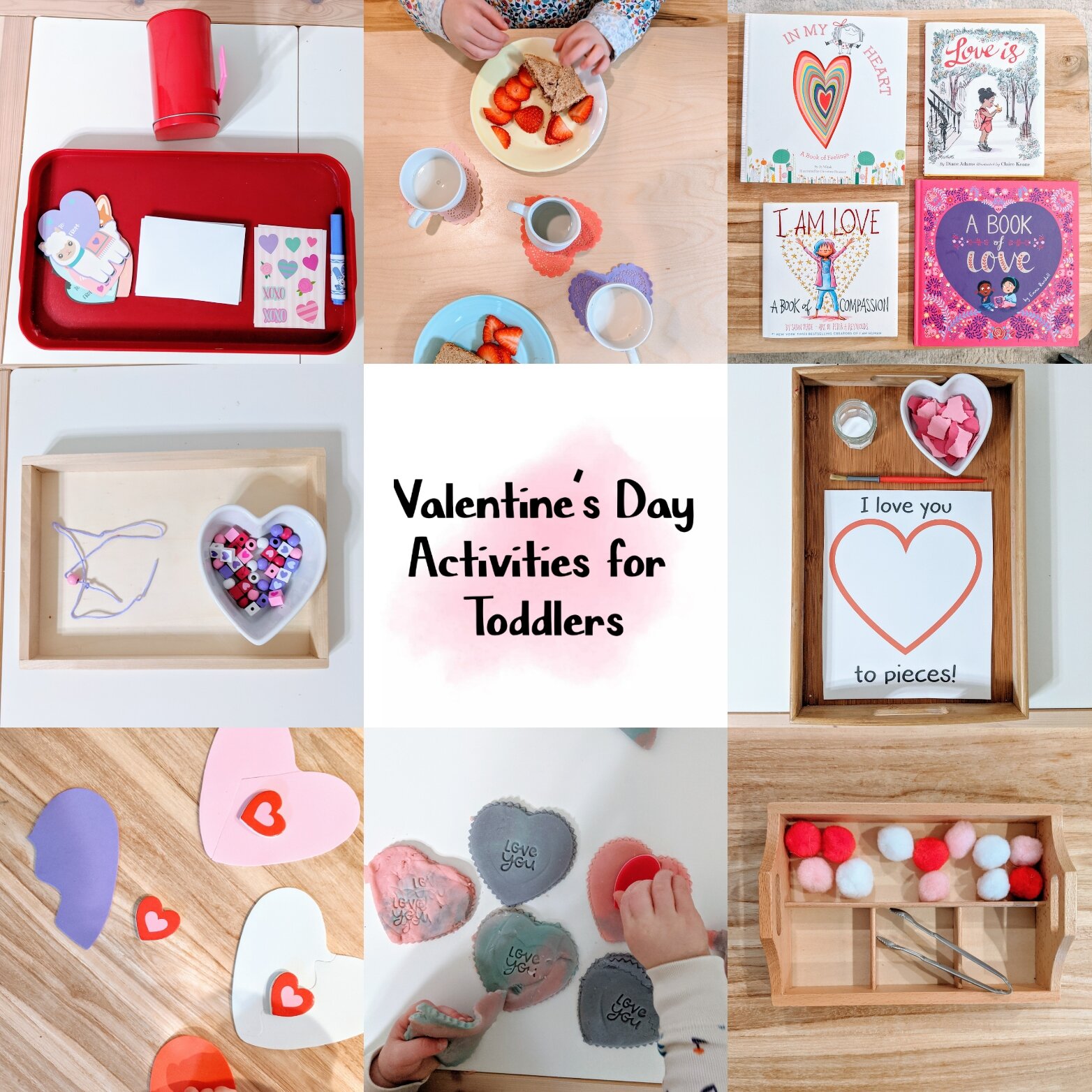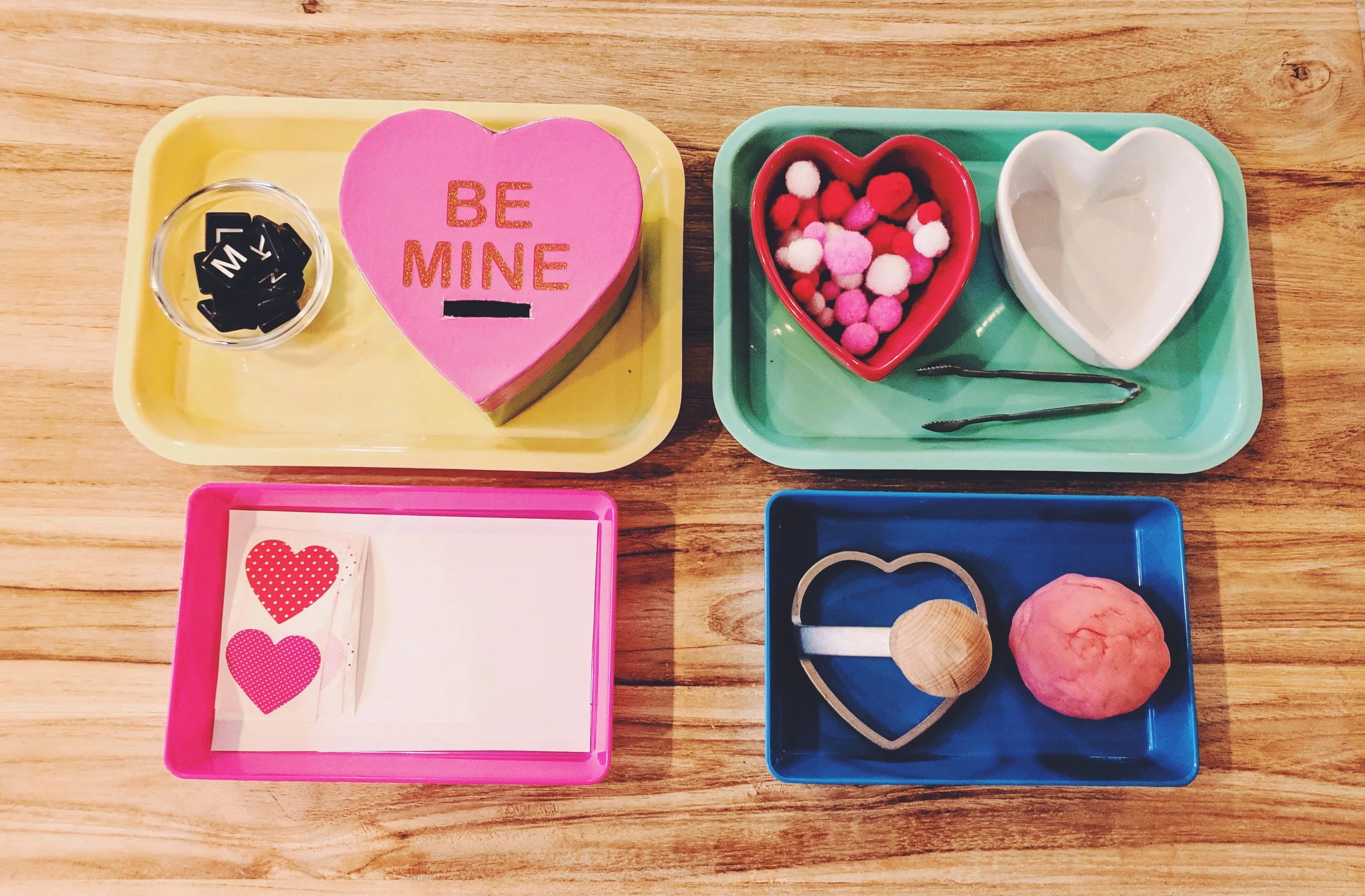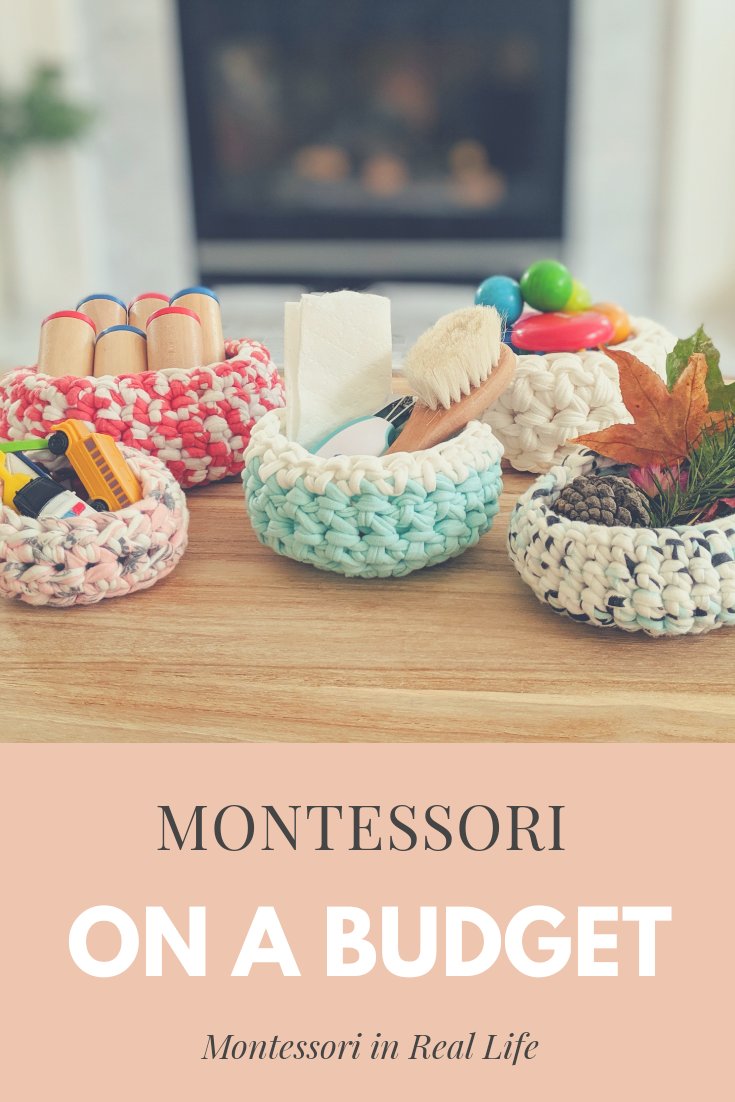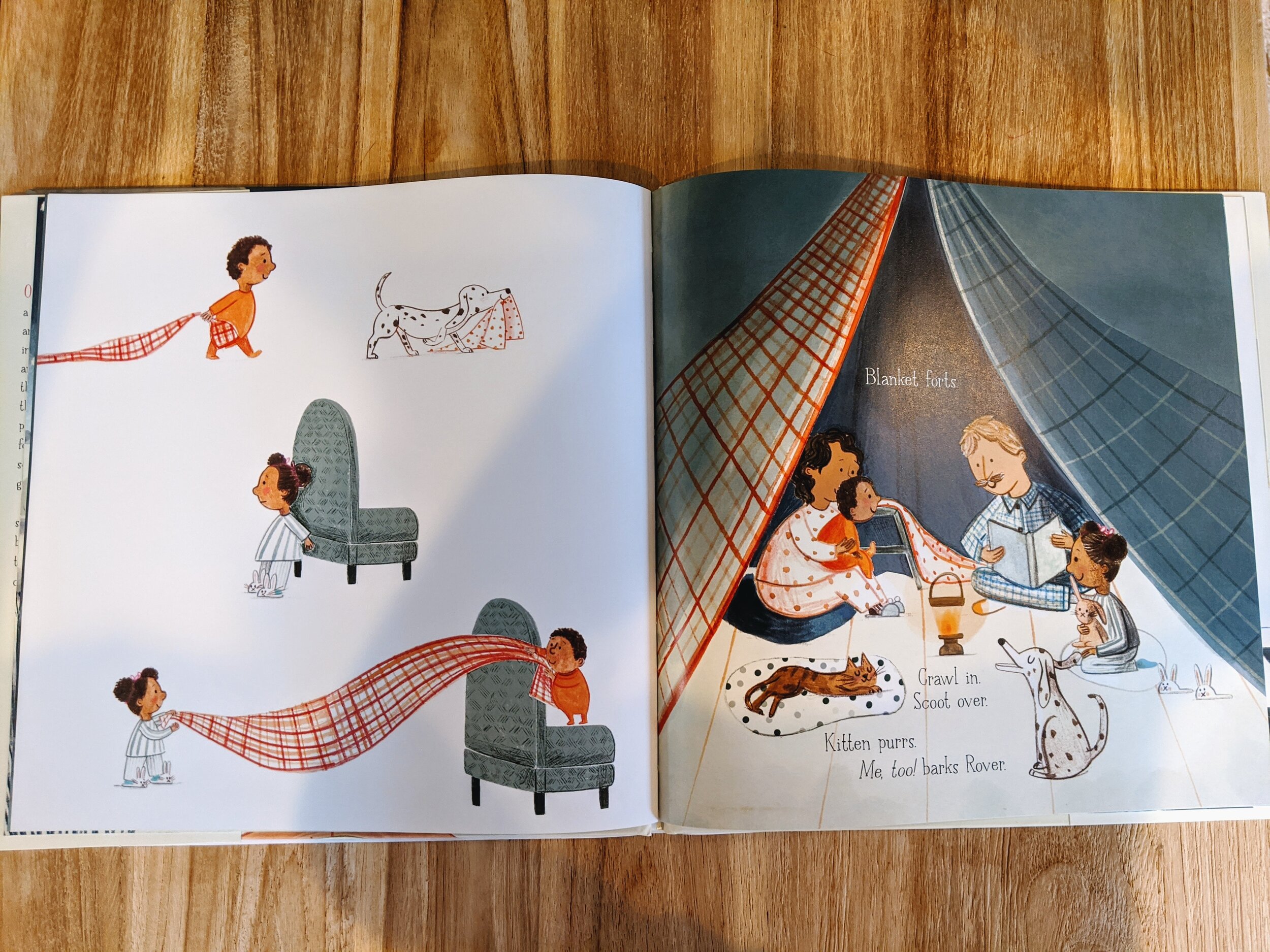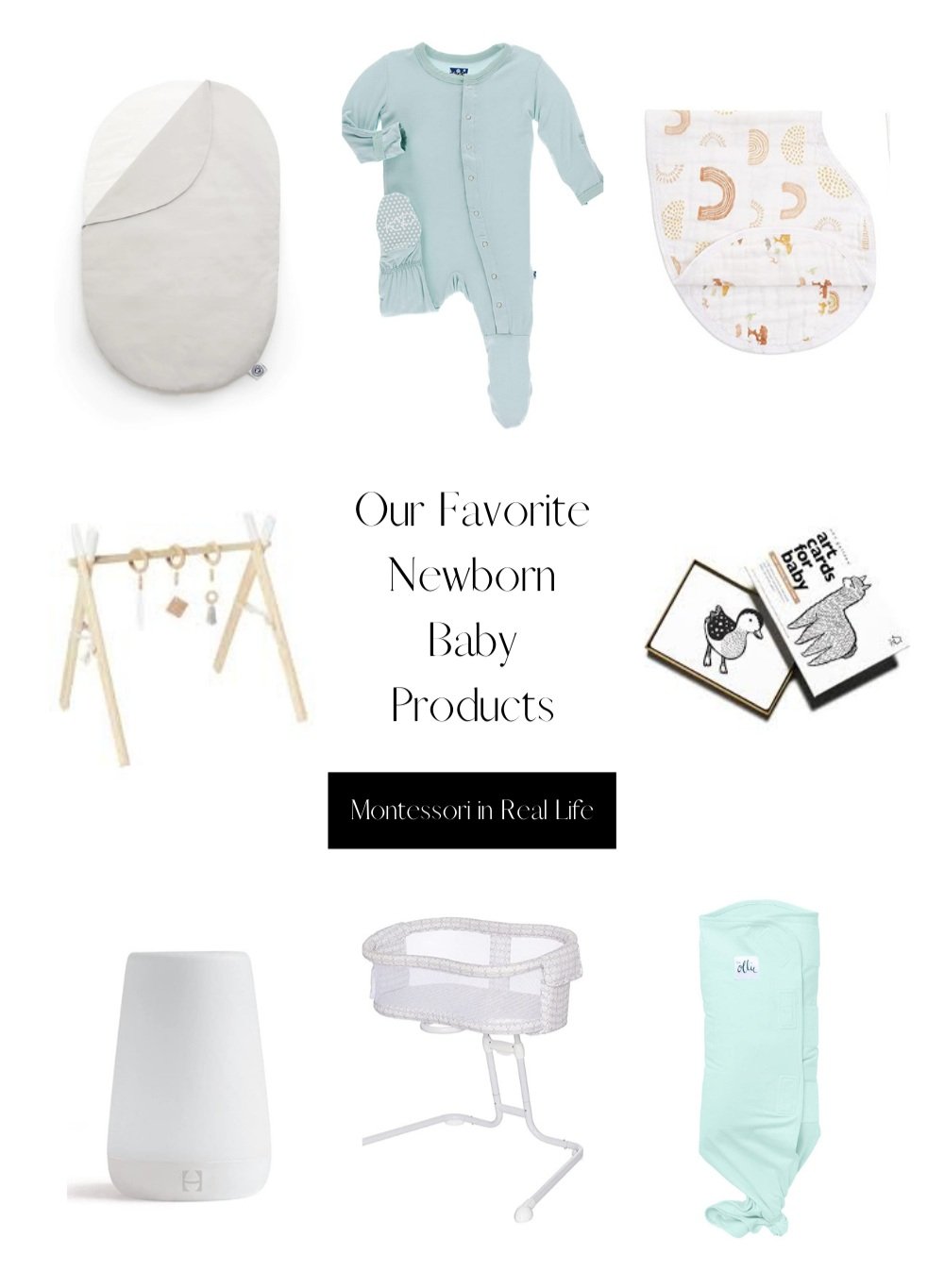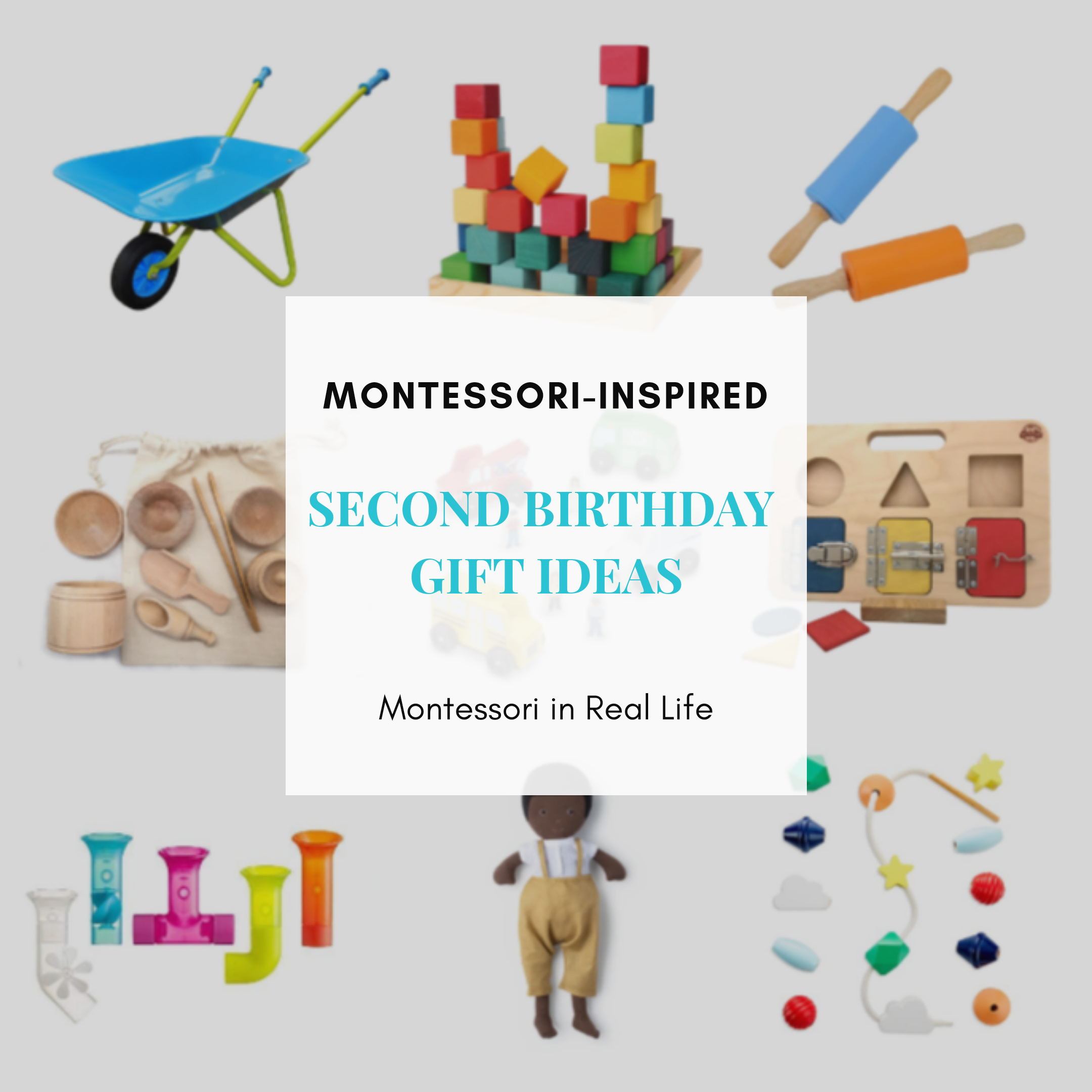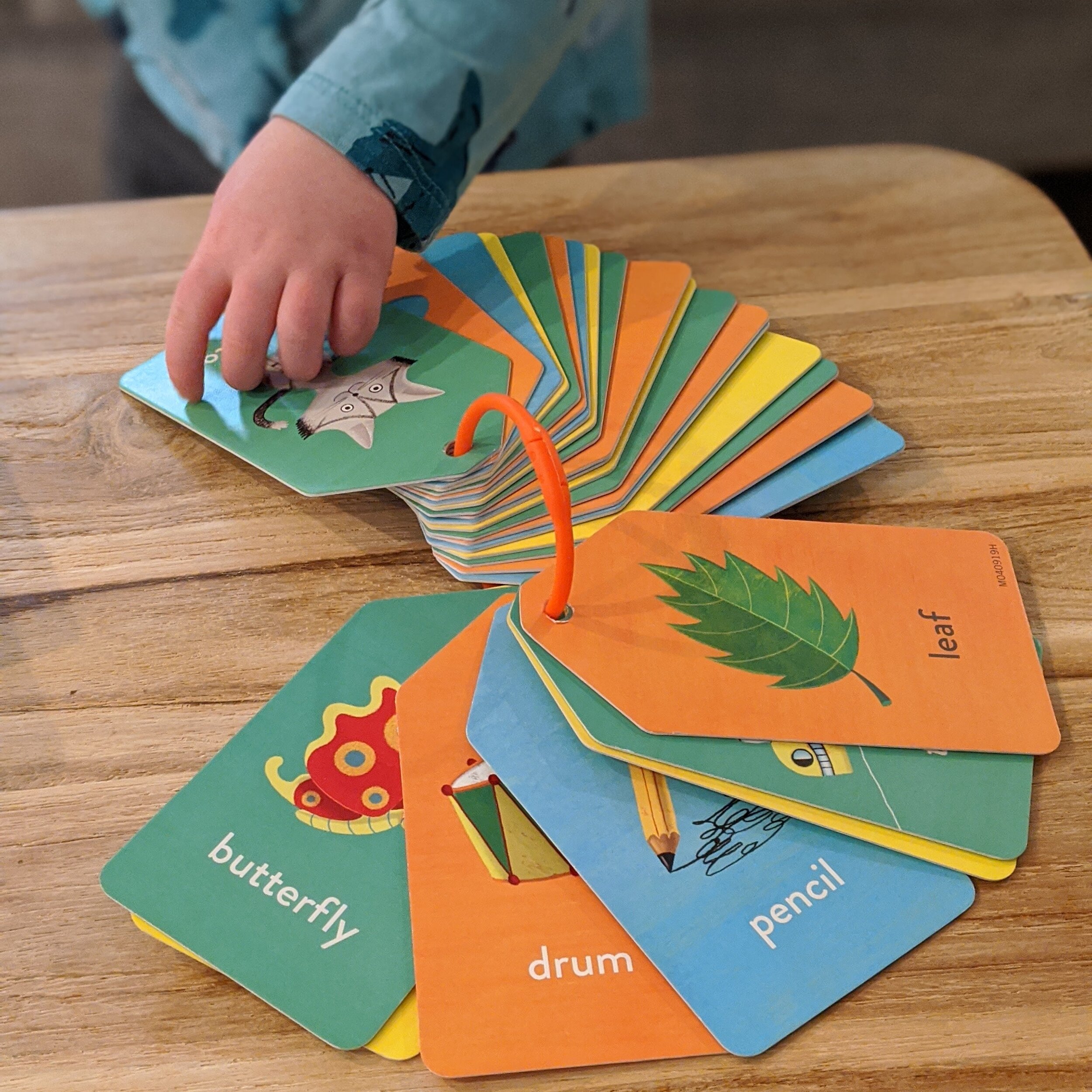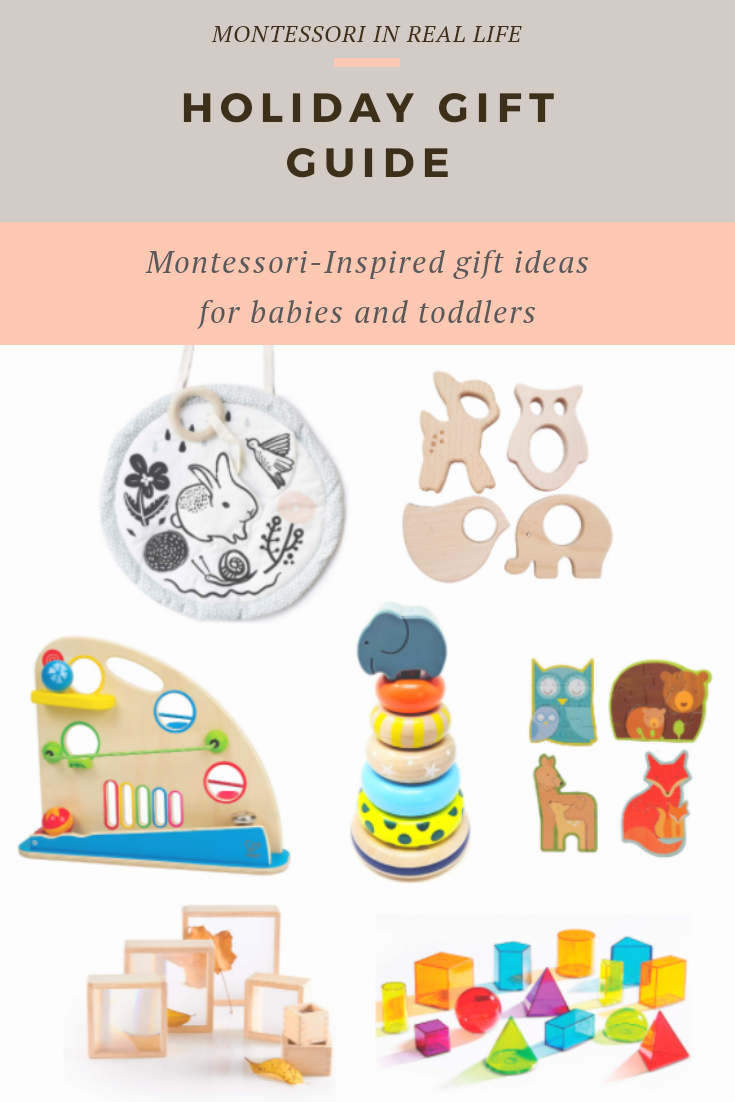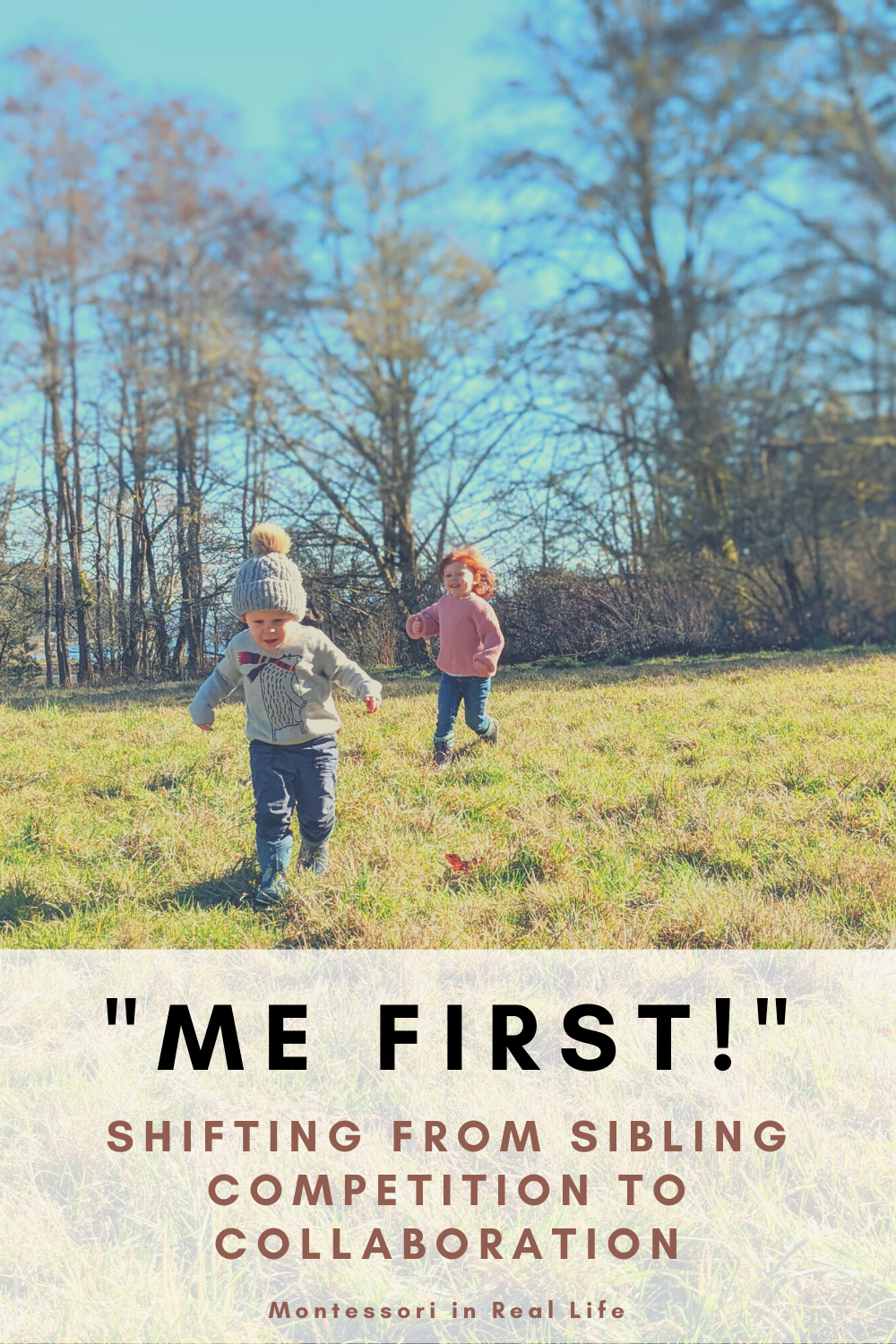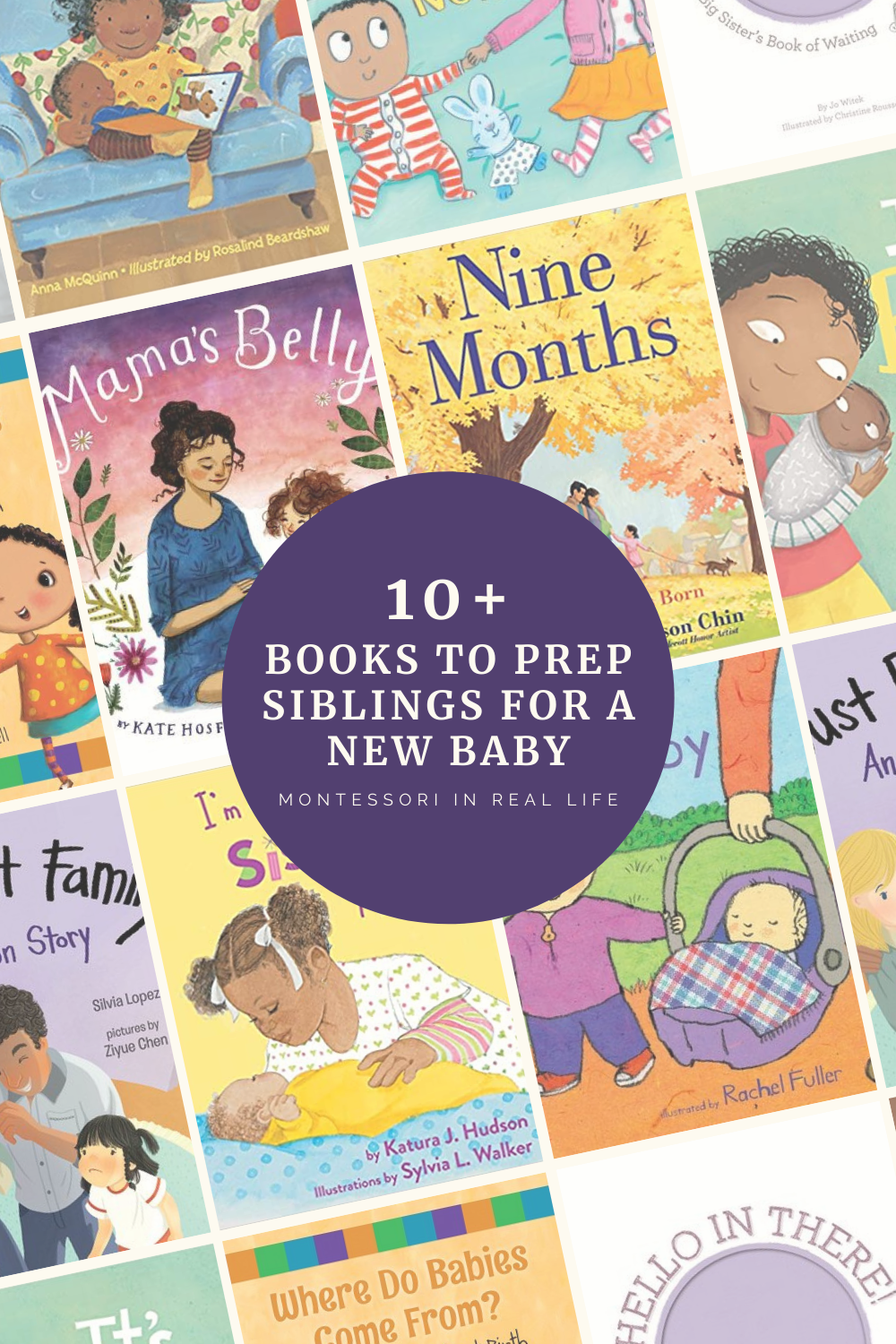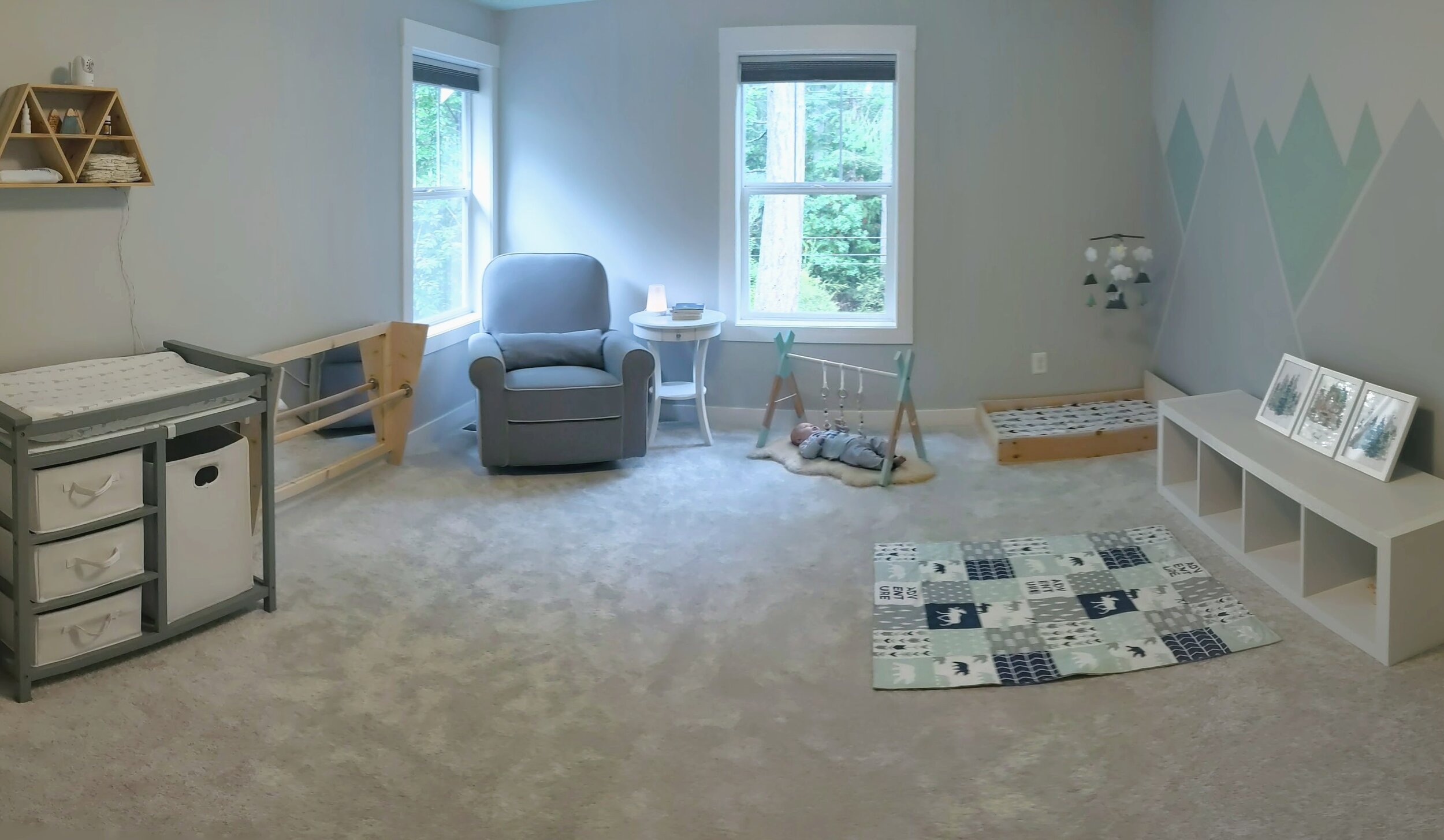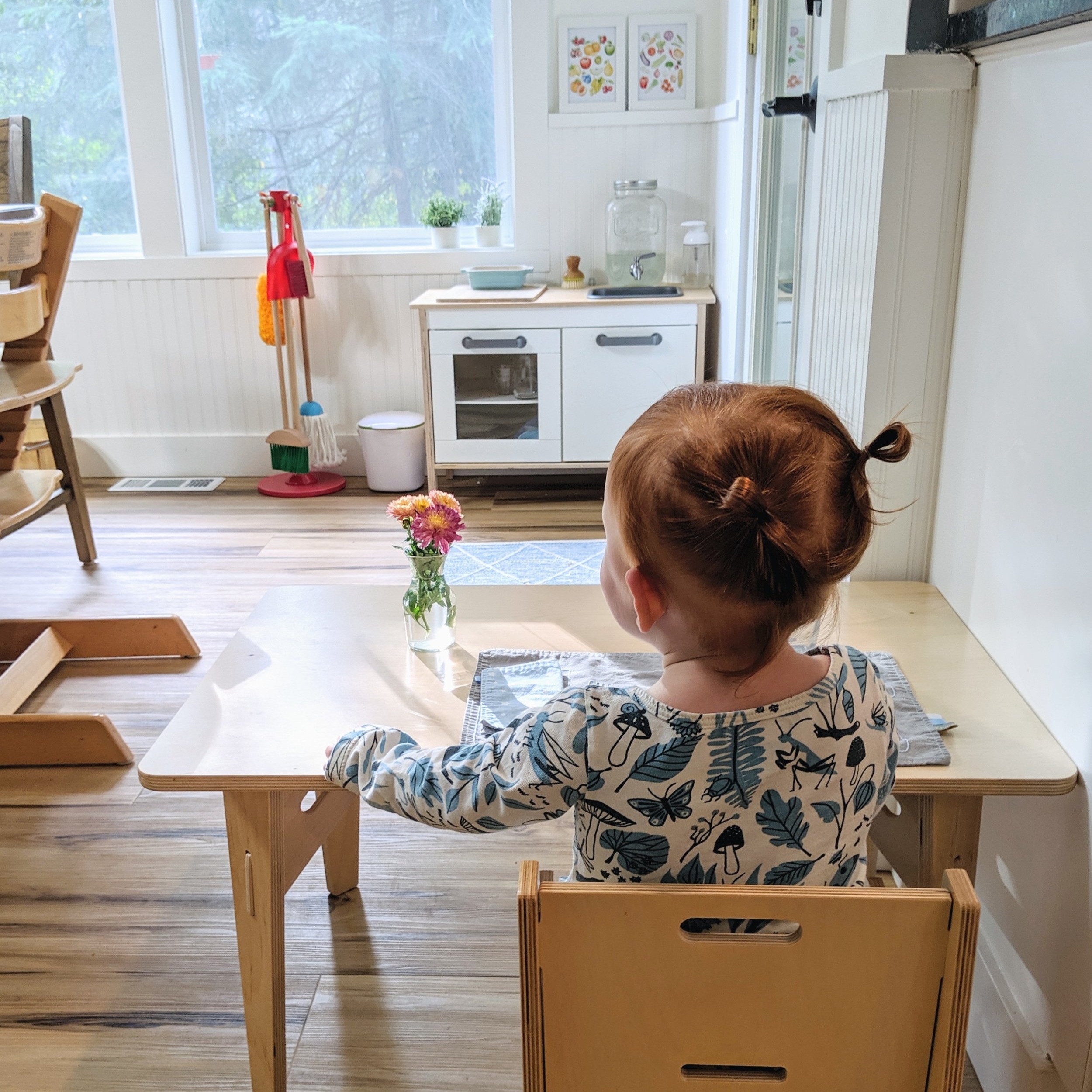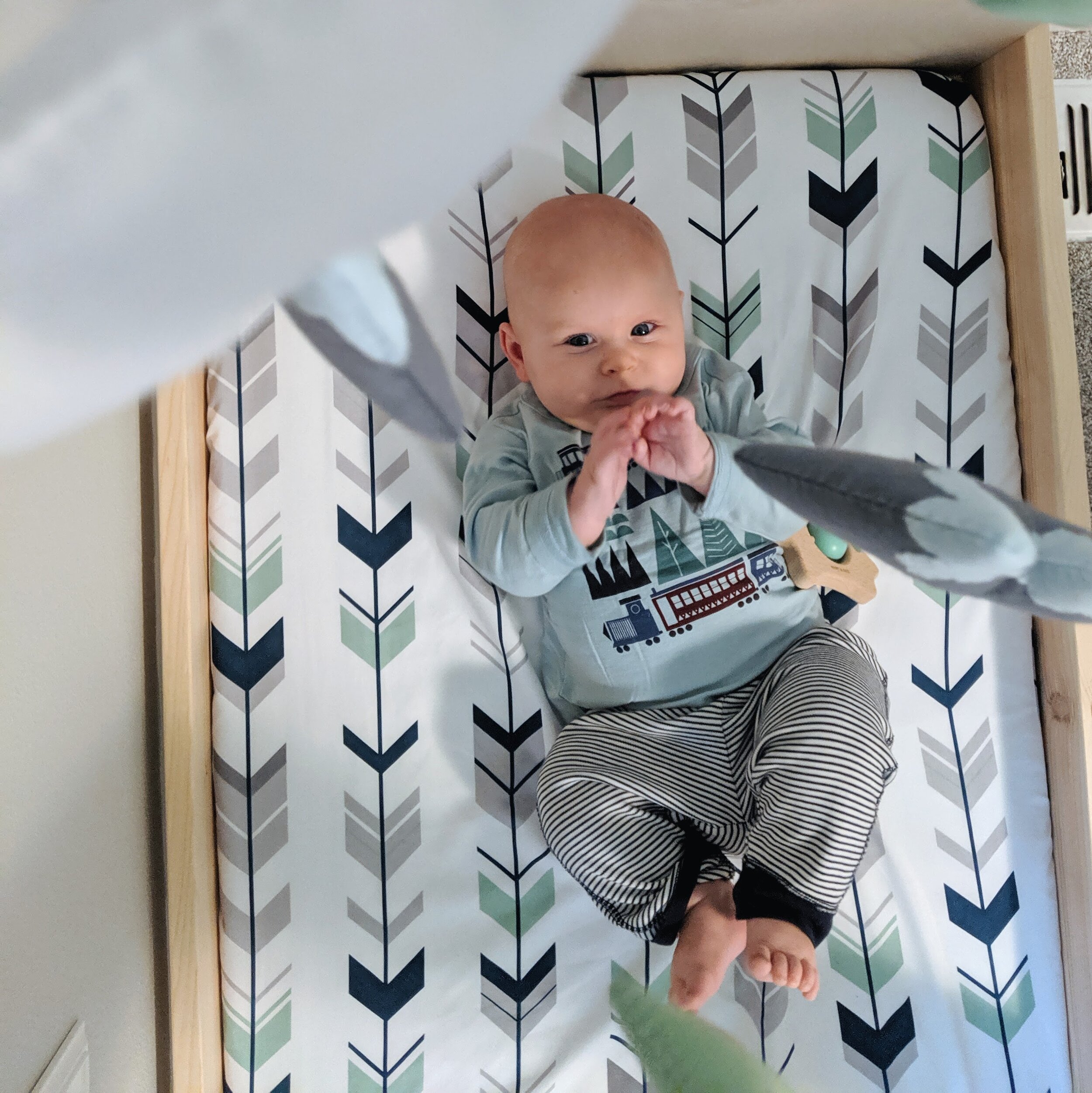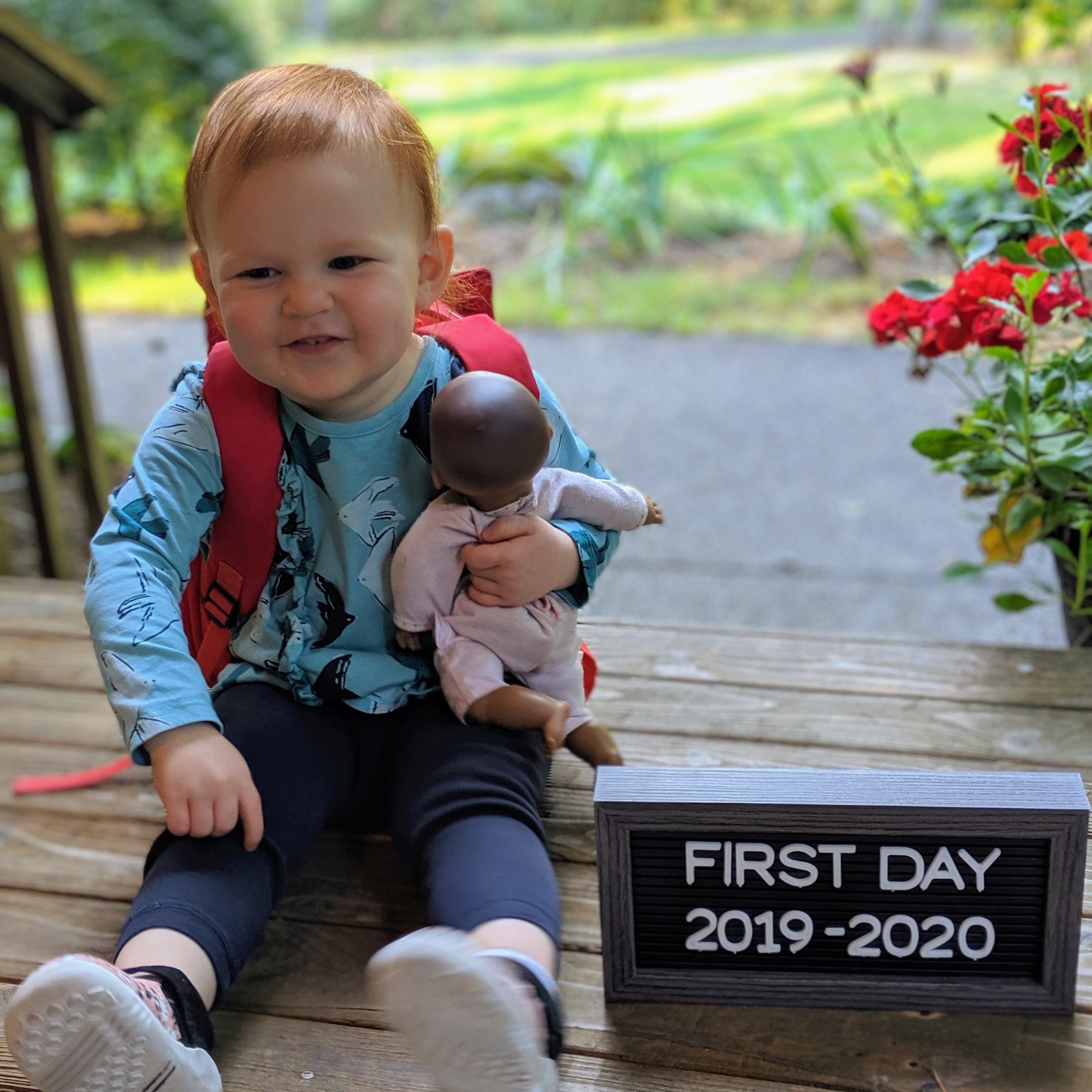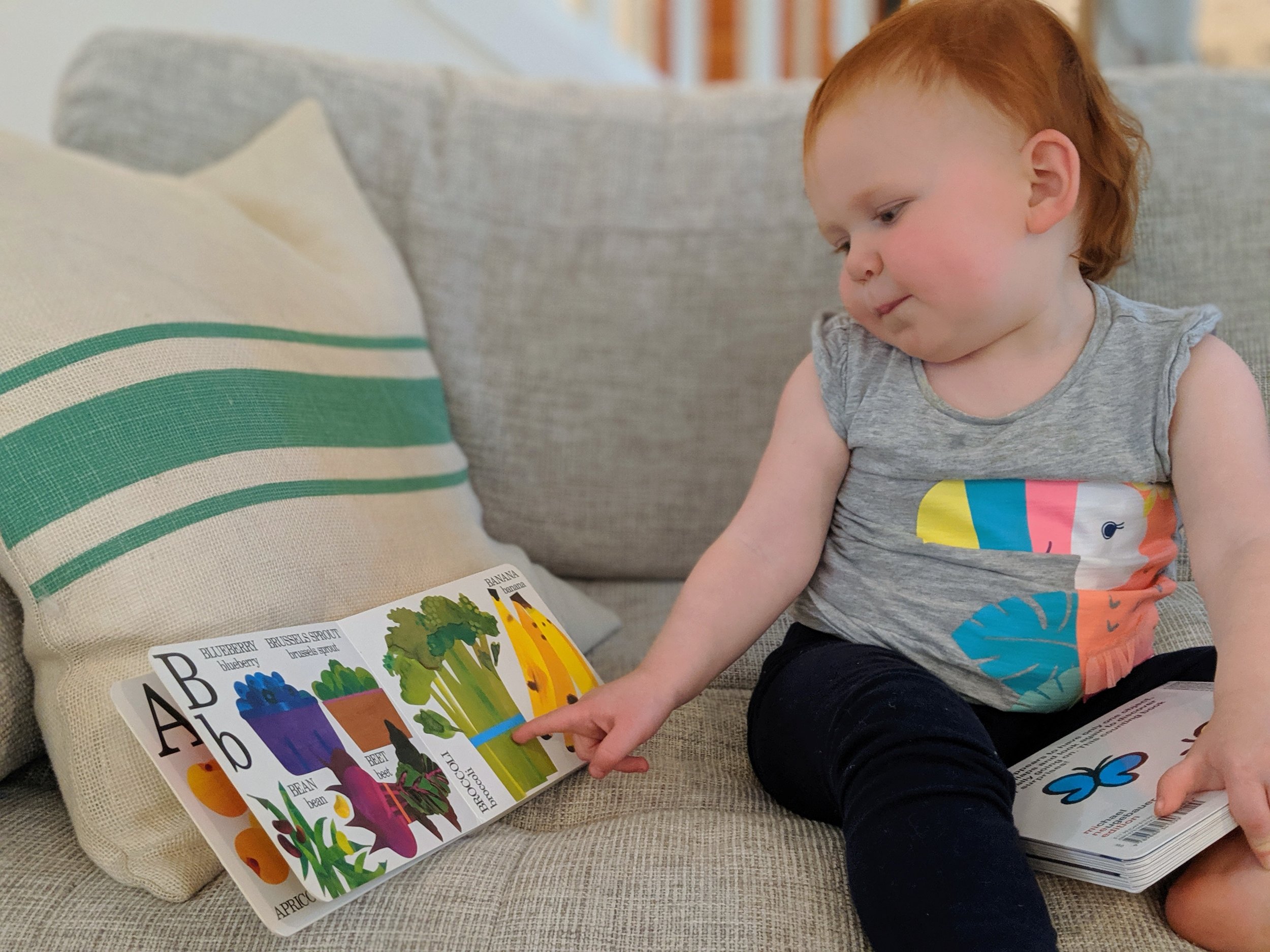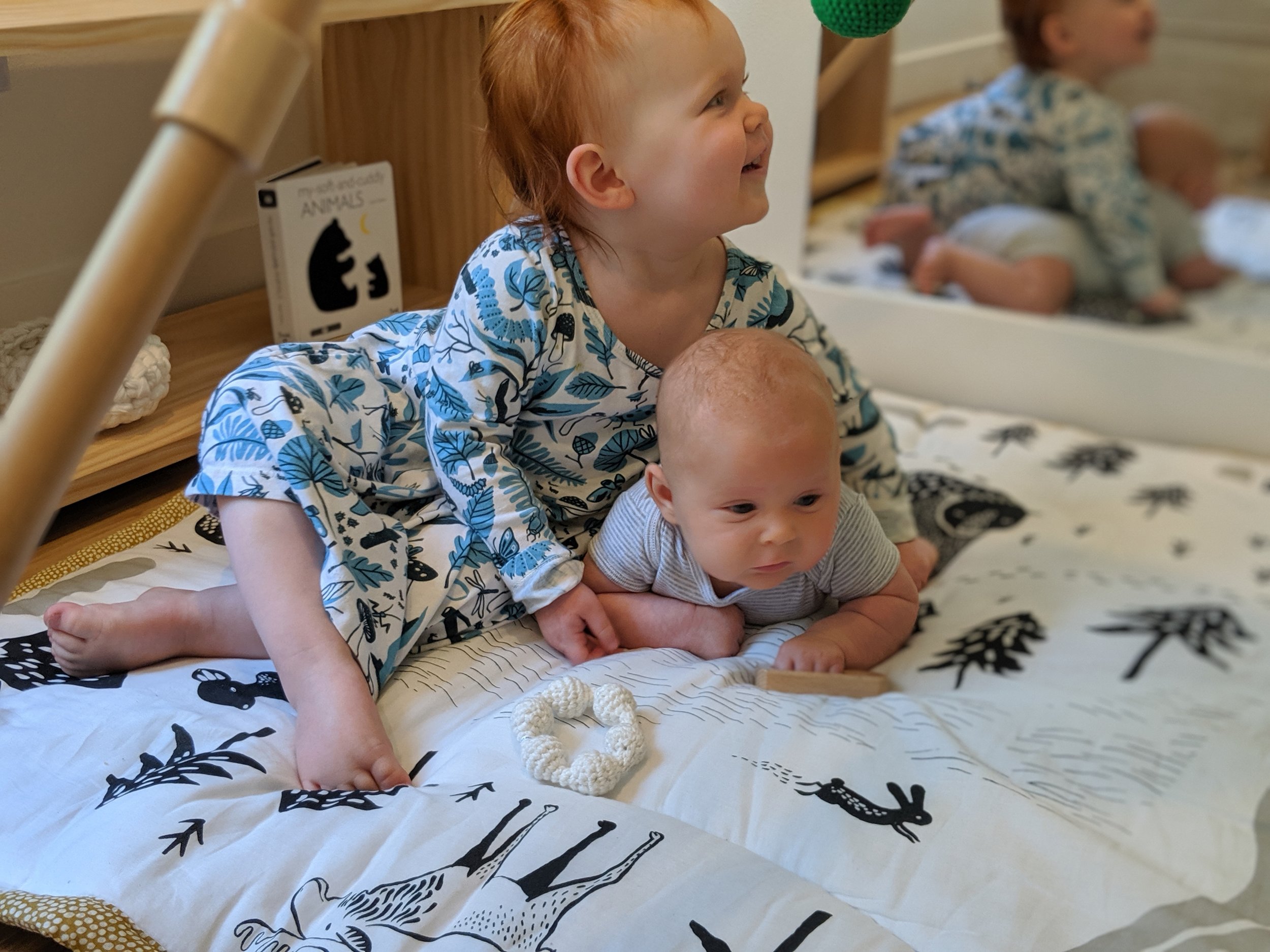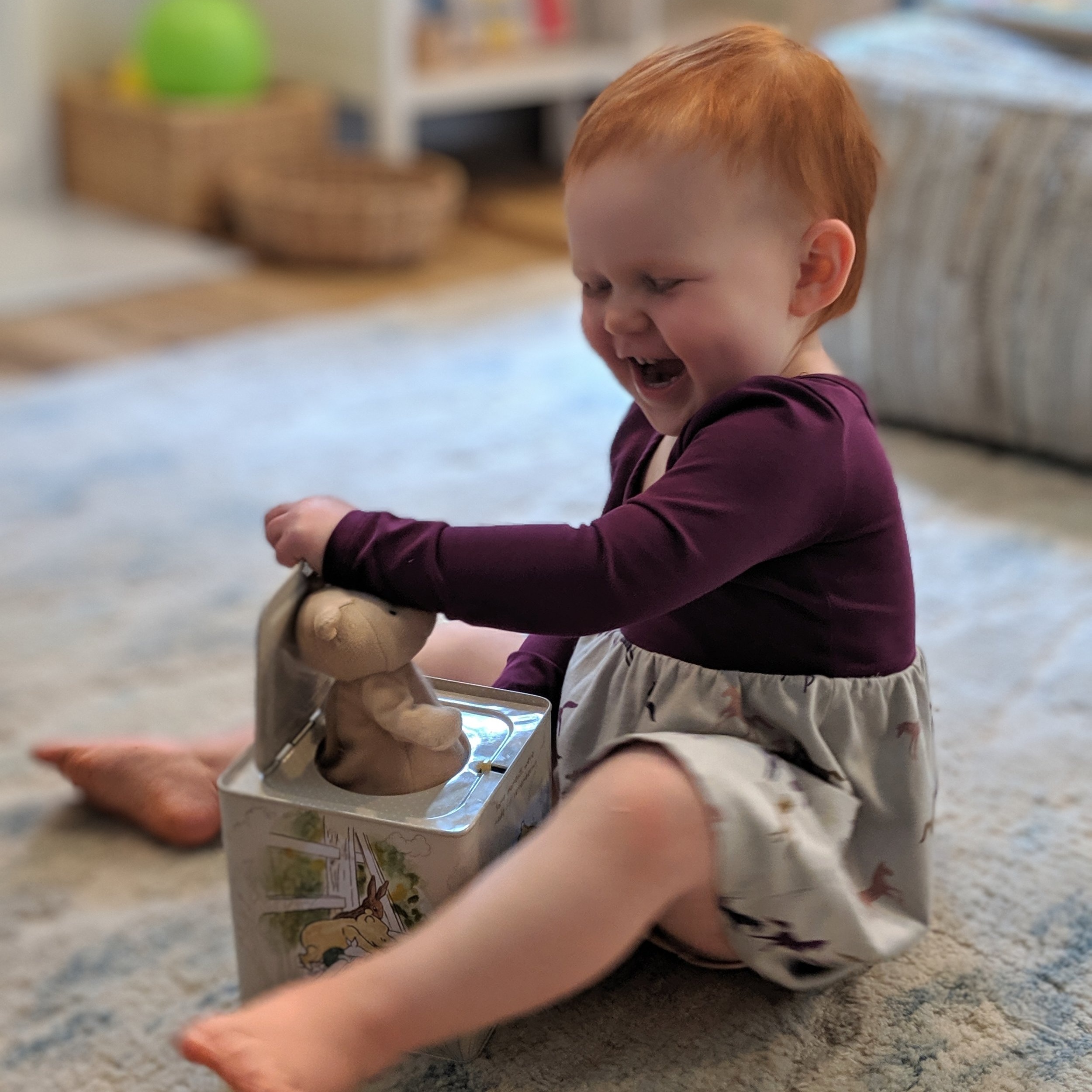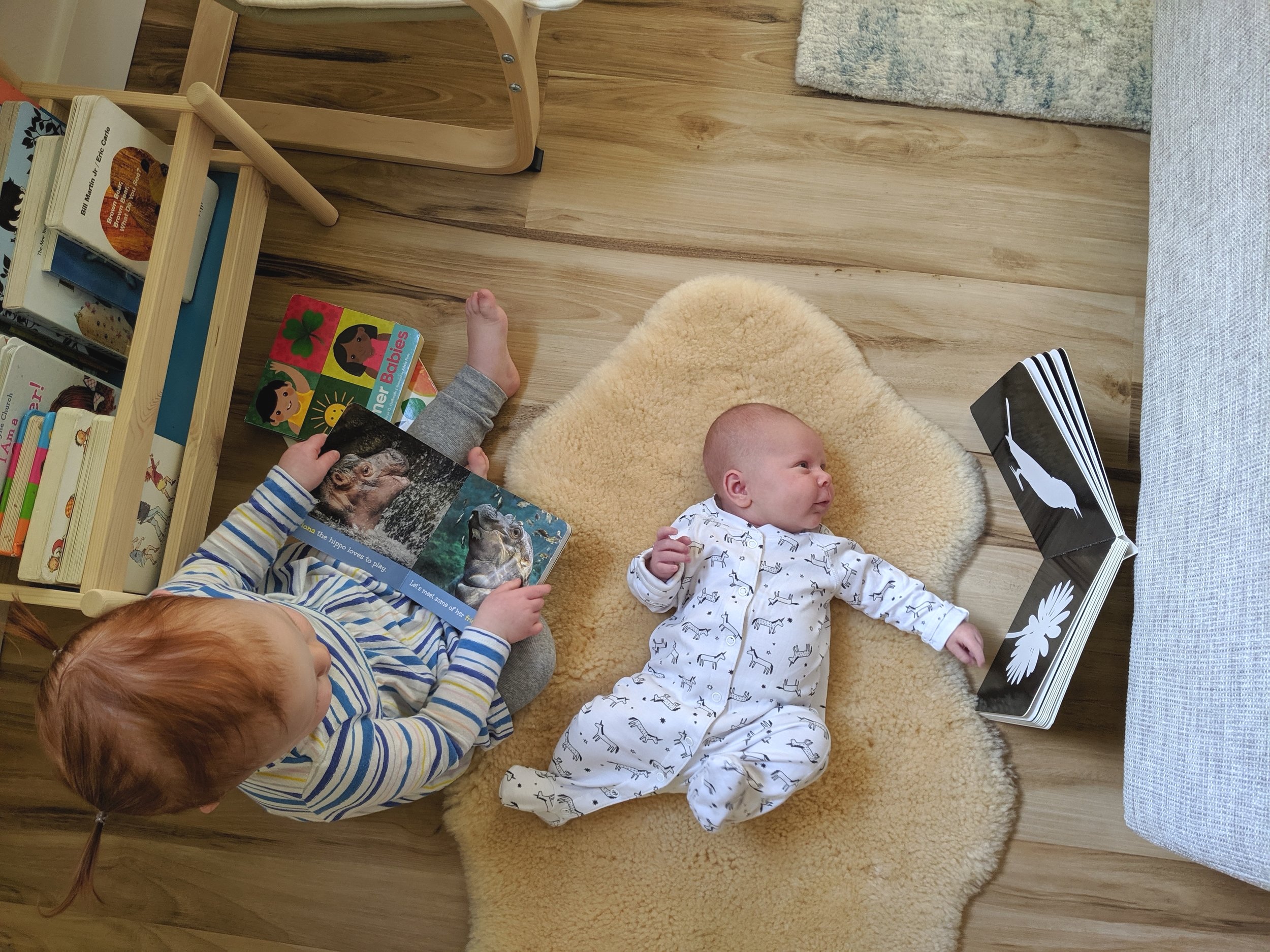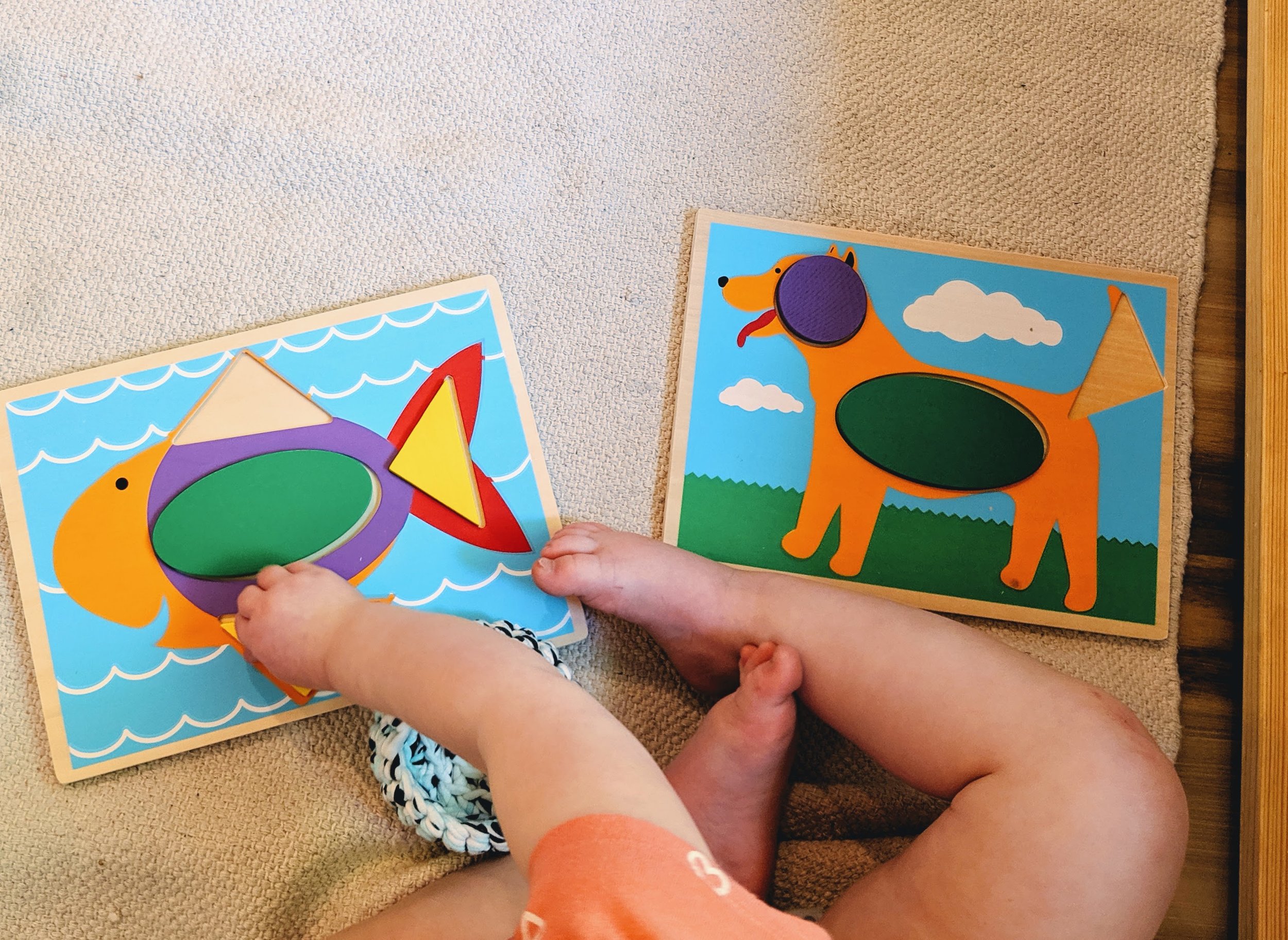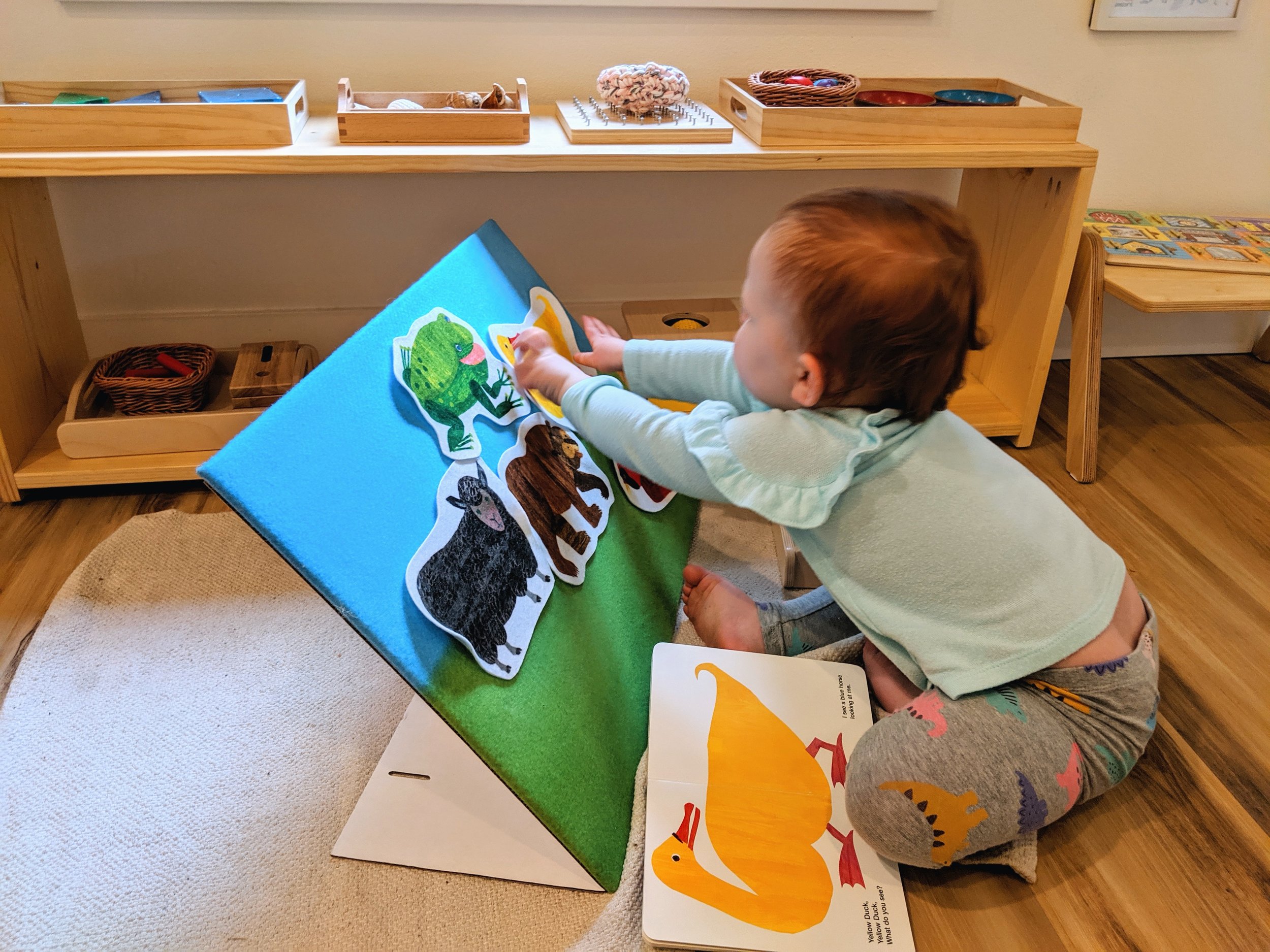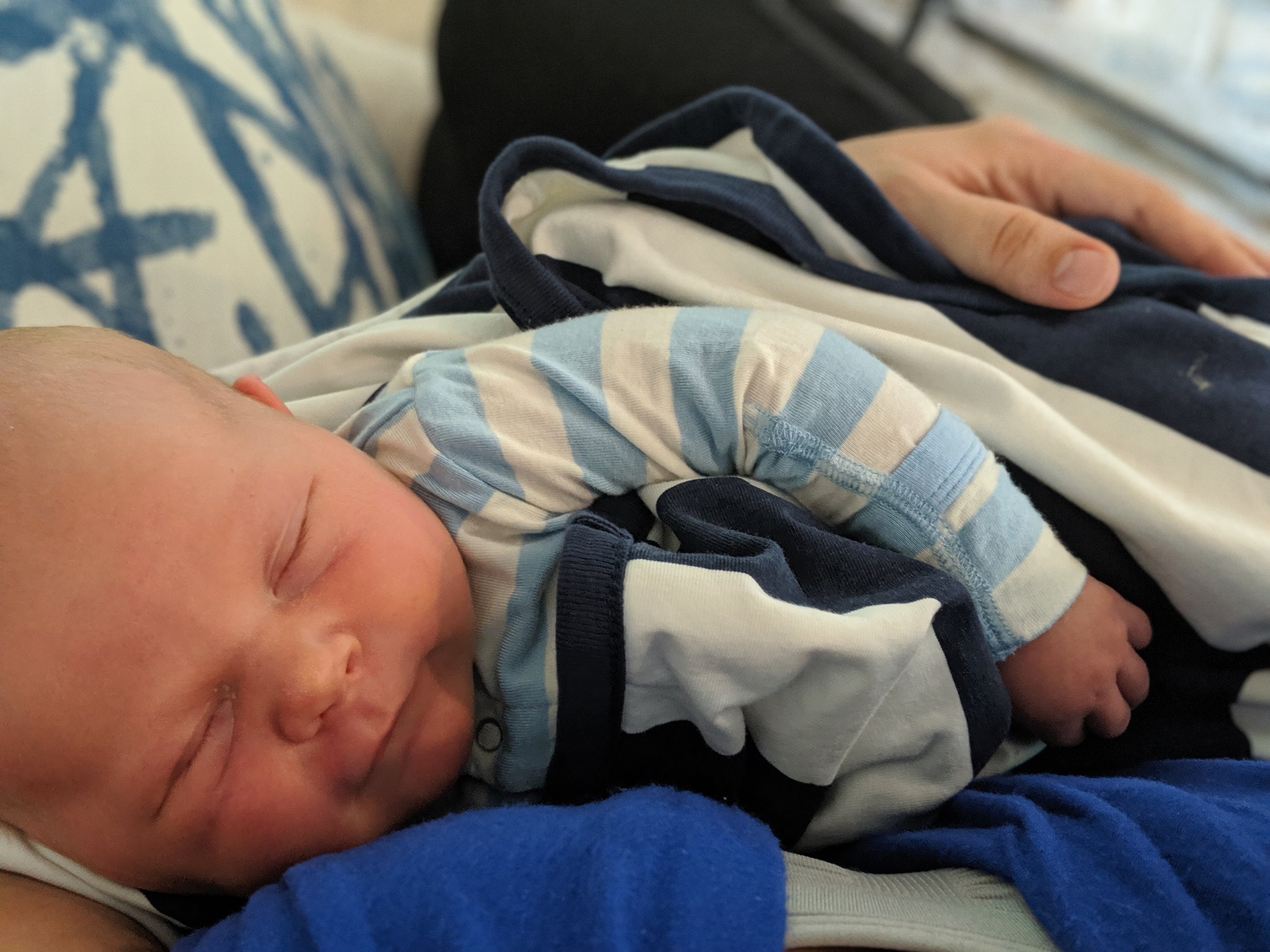Our Montessori Home Tour
Montessori in Real Life
After many questions on the topic, I decided it was finally time for a home tour! Hopefully this will help give you a visual of our home and how we set up Montessori spaces for both our infant and toddler. I have tried to include links to all of the furniture, materials, and decor I often get asked about. I am going to do the home tour in two parts: main floor and upper floor (bedrooms). This is the main floor post. As we don’t have a play room, the main floor living room is where our children work and play. Especially at their ages, I find it easier and more cozy to “coexist” here by making it accessible and welcoming for all of us. With our open floor plan, I can keep on eye on them in the living room from the kitchen. This set-up provides us a nice balance of togetherness and independence.
You’ll notice each of the children’s spaces offer opportunities for independence. Toddlers, and even babies, thrive when they are given choice, freedom of movement, and autonomy to “do it myself”. By setting up a home with accessibility and autonomy in mind, children feel confident, joyful, and respected. I hope this peek into our home gives you a few ideas too!
Entryway
When we head outside, this is where D puts on her socks, shoes and coat. She also takes off her shoes and hangs up her coat when we come back inside. To give her a bit more autonomy, we always keep two options for socks, shoes, and a coat that she can choose from. To help her remember which shoe goes on which foot, I placed corresponding colored dots on her shoes and on the floor (e.g. pink dot on left side of floor and in left boot). To put on her coat, she does the Montessori “coat flip” trick, where she lays it out in front of her (hood towards her feet), puts her arms in the holes and flips it over her head. The beautiful weather sign is from Etsy and the step stool is IKEA. The hooks came from Target Dollar Spot last spring.
D’s Space
This is D’s play of “work of the child’ space. Here we keep her Montessori materials which are rotated every 2-3 weeks to keep her materials inviting and exciting. (Note: I never rotate all her materials at once, but rather choose to switch out just the ones that she hasn’t used at all or has completely mastered and is bored with.) This is where we keep most of her traditional Montessori materials, as well as some of my DIYs. My husband made her shelf but you can find a similar low shelf from Sprout. The small bookshelf is IKEA, as well as her reading chair. (We rotate books every month or so.)
To the right of her chair is her small floor table from Sprout. Right now, we use it to hold her light table up. Though most of her toys get rotated in and out, the Grimms Rainbow and Peg Dolls always stay, as she is regularly using these for color matching and creative play. As for her trays, we like these simple, unfinished wood ones as well as this Beech one. You can find several of her other current shelf materials on my Amazon storefront.
Movement Area
Next to the fireplace, we keep a basket with her movement or gross motor activities. This includes her yoga mat, yoga pretzel cards, roll and play game, silk scarf, stepping stones, and tactile mats. These are always kept here, rather than rotated. We also keep her wavee board and Pikler triangle (which my husband made) out or stored behind our armchairs. All of these activities are especially helpful when we are stuck inside or we need to redirect energy!
Open-ended Toys
In our bookshelf next to the fireplace, we keep open-ended toys in these baskets from Target. We do rotate these materials, but very infrequently. Currently, these baskets house our Way-to-Play roads, wooden vehicles, wooden town set, and Brio train set. I didn’t introduce baskets with this many toys until after her second birthday, when she was no longer interested in dumping, and was willing and able to clean up big messes. It’s best to only put out as many materials as your child can realistically clean up. Other favorite open-ended toys that enter rotation here are Magnatiles, musical instruments, and wooden blocks.
Toy Storage
We re-purposed our coat closet to make a toy storage closet. Priorities right? ;) Thanks to being a former teacher and current blogger, we have a lot of toys and Montessori materials. This cubbie cabinet has worked out perfectly for us. I can see what’s inside each cubby, while still fitting all that I need to inside. The materials that are much too young or old for either child in a couple of plastic bins in the garage. We keep books that aren’t in rotation in our office/TV room on some built-in shelves up high (not pictured). We keep this door closed so that D doesn’t open it, and I only rotate when she’s asleep.
S’ Space
For now it works best for us to keep D and S’ play spaces separate. Though of course they spend time in each other’s spaces, it helps to define their work and give them each a sense of ownership over their belongings. As S is working on crawling and needs a lot of space for free movement, this reversible and washable play mat has worked out really well. My husband also built his low shelf, but again, you can find a similar one from Sprout. I rotate his toys less frequently than D’s, as he enjoys many of his teethers and rattles for weeks on end. We love this acrylic mirror (attached to the wall with command tape) that allows him to see himself and his own movements. You can find several of his materials on my Amazon storefront. The others are a Tag Toys glitter drum, an Etsy puzzle ball, and Essential Montessori cylinder.
Art/Sensory
In our dining room, we keep this IKEA Flisat table and Sundvik chair, used for art and sensory activities. We keep a few art supplies or whatever sensory material we are using in these bins that fit right into the table. Favorite sensory materials include water beads, kinetic sand, rainbow rice, dried beans, and simply water. When the tabletop is on, we use it as an art table for activities like coloring, painting, play dough, stickers, cutting, and gluing. We typically have one or two options available at this table at a time for her to choose from. I store the rest of her art supplies in a kitchen cabinet.
Kitchen
You can read more about how we set up D’s functional kitchen in this blog post. This converted IKEA play kitchen has served us for over a year (introduced around 16 months, with water dispenser around 18 months). This is where we keep her dishes (such as these plates and cups), utensils, cooking tools, and cleaning supplies (such as this set and these washcloths). She washes her hands here as well as serves herself water. We don’t use this for dish washing as much as the kitchen helper at our sink these days.
My husband made her the kitchen helper and it is used at least twice a day. She loves to help me prepare meals or sometimes just have a snack and watch. If you are looking to purchase one, I recommend this simple one for older toddlers/children or this larger, more stable one for younger toddlers.
Dining
Though both of our children eat family meals at our dining table in their Stokke Trip Trapp chairs, they also love their small Sprout weaning table. Although not necessary, we find benefits to having both options. Typically, D eats her breakfast and snacks at the weaning table (S joins her for breakfast these days). Lunch and dinner happen at the family table. The Stokke chairs are nice because they pull right up to the family table, the baby set comes off, and the height is adjustable to work for many years. D started climbing into the chair herself around 20 months. The weaning table is wonderful because D can set her own place and clean up after. We love her beautiful Khadine Deco placemat with outlines for setting her place.
Bathroom
Our downstairs bathroom is pretty tiny, so there isn’t much room for self-care. We do squeeze in this small potty and step stool which she can use to get dressed or store her tissues or hairbrush. She also uses this stool to wash her hands at the sink, but needs my help turning the faucet on. (Upstairs, in our larger bathroom, we use this taller step stool so she can independently turn on sink and brush her teeth.) While we have an insert so she can sit on our toilet, she much prefers the small potty, which she feels more comfortable using all by herself. In the basket of our vanity we keep a couple of pairs of underwear, several books, and wipes. It is very rare for her to have an accident these days, but it’s always good to have a change of clothes available.
PS. Our couches and coffee table are from Article!
Note: This post contains affiliate links. If you purchase a product through one of these links, you won’t pay anything extra, but I will get a small commission, which helps keep this blog going. Thanks for supporting Montessori in Real Life!
